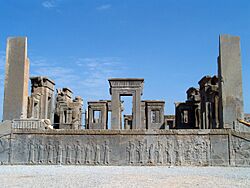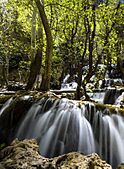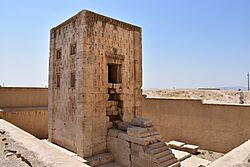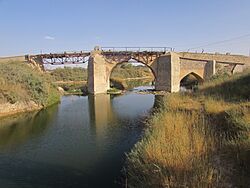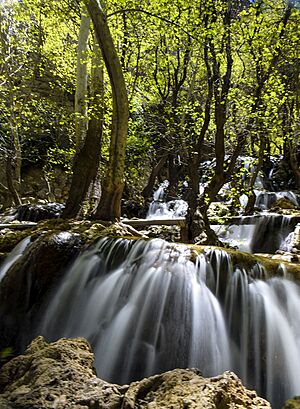Marvdasht facts for kids
Quick facts for kids
Marvdasht
Persian: مرودشت
|
|
|---|---|
|
City
|
|
|
From top to bottom, left to right: Persepolis, Tomb of Darius the Great, Tange Bostanak, Cube of Zoroaster, Pol-e Khan
|
|
| Country | Iran |
| Province | Fars |
| County | Marvdasht |
| District | Central |
| Population
(2016)
|
|
| • Urban | 148,858 |
| Time zone | UTC+3:30 (IRST) |
Marvdasht (Persian: مرودشت) is an important city in the Fars province of Iran. It serves as the main city for Marvdasht County. This region is famous for its deep historical roots and ancient sites.
Contents
Population in Marvdasht
The city of Marvdasht has grown quite a lot over the years. In 2006, about 123,858 people lived there. By 2011, this number increased to 138,649 residents. The latest count in 2016 showed the population reached 148,858 people. This shows Marvdasht is a growing city in Iran.
What Does Marvdasht Mean?
Historians have a few ideas about where the name Marvdasht comes from. Some believe it was once the name of a neighborhood in the ancient city of Estakhr. Over time, the name Marvdasht might have spread to cover the whole area.
Another idea is that "marv" was the name of a plant that grew locally. The word "dasht" means "plain" in the Persian language. So, Marvdasht could mean "plain of the marv plant."
History of Marvdasht
Marvdasht has a history as old as Iran itself and the Persian Empire. The famous ancient capital, Persepolis, is very close to the city. Just a few kilometers away, you can find other important historical sites. These include Naqsh-e-Rostam, Naqsh-e Rajab, and the ruins of the ancient city of Estakhr. These places show how important this region was long ago.
Archaeological digs have found proof that people lived in the Marvdasht Plains thousands of years ago. This was even before Darius chose the plains near Mount Rahmat for his royal home.
How Modern Marvdasht Grew
The modern city of Marvdasht started to develop in the 20th century. In 1935, a sugar factory was built here. This factory helped the city grow. More and more people moved from nearby villages to settle in Marvdasht. Some even left their nomadic way of life.
Before the Islamic Revolution, Marvdasht became a major industrial city in Fars province. Many factories were built, like a petrochemical complex and companies making household appliances. These factories needed many workers. Because of this, Marvdasht's population grew rapidly. It became the second-largest city in Fars province.
The land around Marvdasht is very fertile. This made the area a big center for farming in Iran. Farmers here grow a lot of wheat, corn, tomatoes, and cucumbers.
Geography of Marvdasht
Marvdasht is located in the northern part of Fars province. It is about 45 kilometers north of Shiraz. The city sits at an altitude of 1620 meters above sea level. The entire county of Marvdasht covers an area of 3687 square kilometers.
Marvdasht County has three cities: Marvdasht, Seydan, and Kamfirouz. The county is also divided into four main areas: Central, Kamfirouz, Doroudzan, and Seydan. The weather in Marvdasht is cold in the hilly parts and more moderate in other areas.
Higher Education in Marvdasht
Marvdasht is also a center for learning. The city has several universities. These include Islamic Azad University, Marvdasht Branch, and Payame Noor University, Marvdasht center. There are also branches of the Technical and Vocational University and the University of Applied Science and Technology.
Archaeological Discoveries
Archaeology is the study of human history through digging up old sites. From 1956 to 1965, a team from Tokyo University explored the Marvdasht plain. They found many interesting things.
They dug at several ancient mounds near Marvdasht and Persepolis. These sites include Tall-i Bakun A and B, Tall-i Gap A, Tall-i Jari A and B, and Tall-i Mushki.
At a site called Tall-e Gap, archaeologists found many ceramic items. This site was an important settlement for the ancient Bakun culture. It dates back to about 5,000 BCE, during a time known as the Chalcolithic period.
See also
 In Spanish: Marvdasht para niños
In Spanish: Marvdasht para niños


